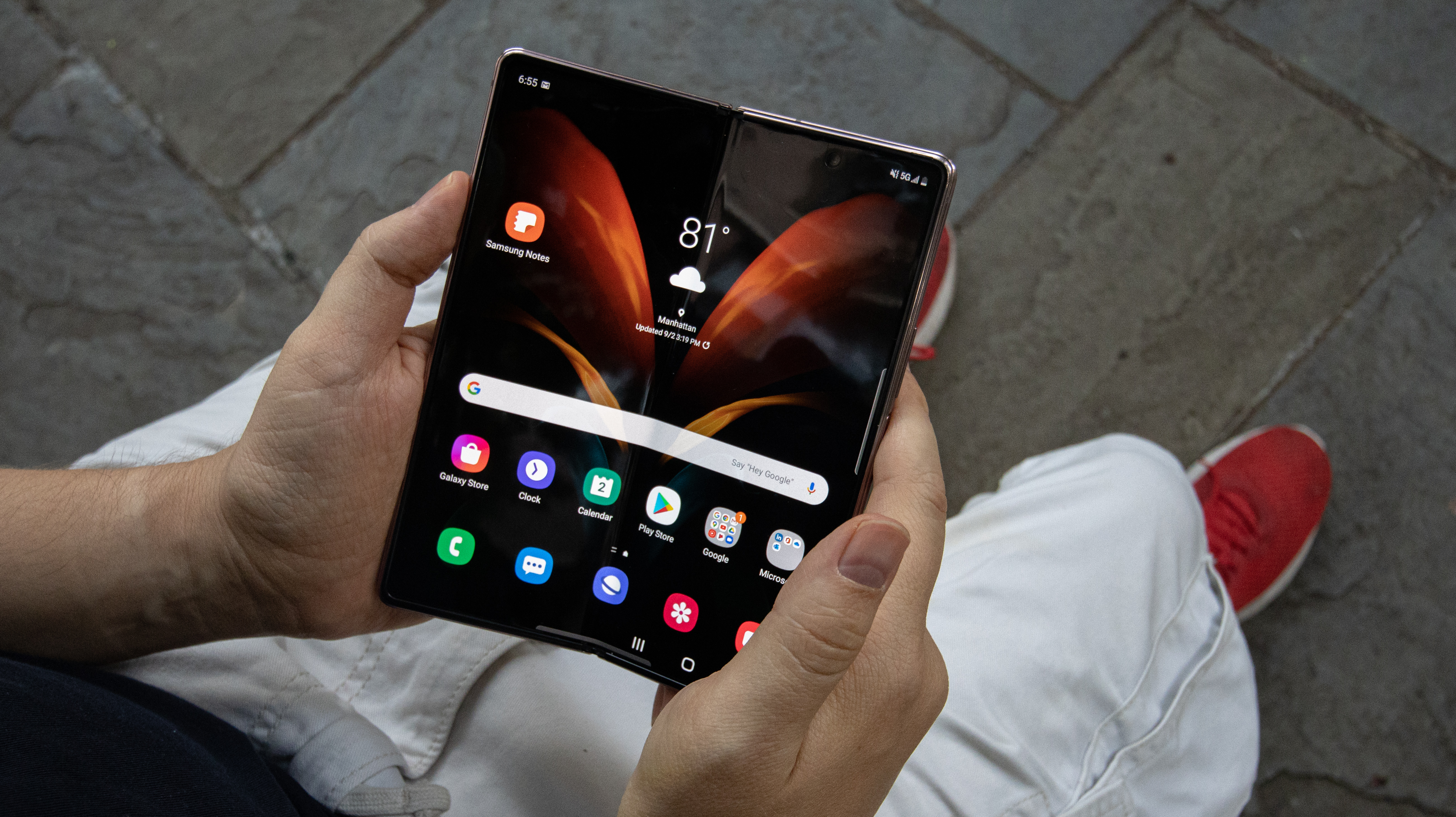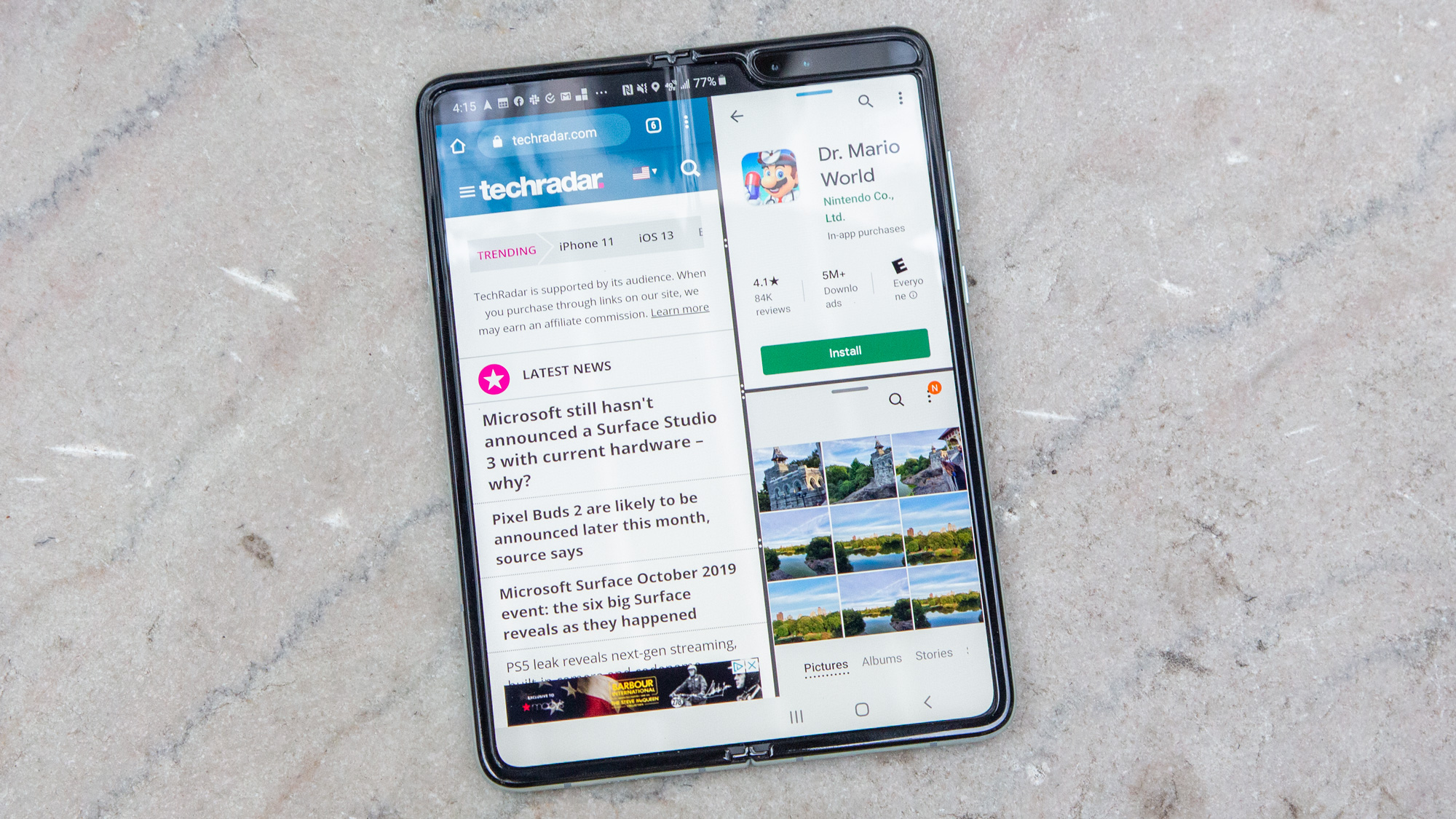How Samsung's first foldable phone mistakes paved the way for Galaxy Z Fold 2
Trials and tribulations of making a foldable phone

Unlike a lot of phone manufacturers, Samsung has fully embraced the introduction of flexible screen technology, and it’s currently the company with the most foldable phones available to buy right now.
Samsung started its foldable run by unveiling the Samsung Galaxy Fold in February 2019, then following with the Galaxy Z Flip early in 2020 (and a refreshed 5G variant landing in July this year). The company’s efforts culminated in the Galaxy Z Fold 2, which is arguably the best-rated foldable phone on the market. In fact, we’ve just named it our best foldable phone of 2020.
There isn’t a huge amount of competition out there for that accolade right now, but with expanding competition from Motorola and Huawei as well as smaller manufacturers like Royole, the number of foldable phones on the market is only going to increase in the coming years. We already know that TCL, Oppo, Xiaomi and more are also exploring the form factor, and there are a handful of vague rumors around the supposed iPhone Flip.
Samsung finds itself in a unique position then – above the fold (get it?) of many of its rivals, so how is it using its experience of making foldables to maintain its advantage?
TechRadar spoke to Yoojin Hong, Vice President and head of User Experience for Mobile Communications at Samsung Electronics, to dive into the difficulties of developing foldable phones, and how the company is embracing a whole new era of phone design.
Deconstructing the tent
“We have always been observant of user behaviors, and their unmet needs, and through this process [selling the Galaxy Z Fold] we were able to learn a lot”, says Hong. “What we found from the first generation Fold was that a lot more people use multi-active window[s] than we would have thought. It was an opportunity for us to validate the predictions we had made in our research.
“Some of the refinements we made include a better multi-active window and we introduced the Flex Mode, which was not available in the first generation Fold.”
Sign up for breaking news, reviews, opinion, top tech deals, and more.
Samsung’s Flex Mode was first introduced on the Galaxy Z Flip, which is a foldable phone with a different design ethos that uses the folding screen tech to make a smaller device rather than a tablet-like larger screen. Flex Mode allows you to keep your phone in a folded state to act like a stand, which you can see below:


“At the beginning, we tried to make this like a tent mode”, Hong explains demonstrating on a Samsung Galaxy Z Fold 2. She demonstrates with the phone at a 90-degree angle bend with the main inner screen facing toward a table allowing for it to stand up on its own.
In this example, you would then be able to watch content on the front display.
“In the end we kind of reduced every other possible mode into the one we decided to call Flex mode” says Hong, “but in the beginning there were all sorts of possible modes. Landscape half folded, and then also portrait half folded – it was a mixture of the external display and internal display.”
If the tent-like mode had been a focus, it would have allowed users to watch video on the device’s front display rather than using the main display. That arguably would have saved battery life as you wouldn’t be powering the larger screen, but Samsung would have needed a larger front display that would likely cost more to make.
That said, Flex Mode makes more sense on the Fold line of products as it allows you to use the better quality main screen. This is just one of the many little elements Samsung is experimenting with on its foldables.
Samsung “worried that the screen may be a little too small”
For the Galaxy Z Fold 2, Samsung increased the front display on the device from a 4.6-inch from the first-gen to a 6.23-inch display. It’s remarkably larger, and makes the front of the phone far easier to use without you having to unfold the device.
Why did Samsung decide to do that? Feedback on the first-generation Fold from customers and other sources. Hong says, “The cover screen in the first generation Fold was also very interesting. When we first launched the Fold, we have to admit we were a little worried that the screen may be a little too small.”
We found that to be the case in our time with the original Fold. We called the screen “cramped” in our review, and whatever you were looking at on the display did get lost in the swath of thick bezel around the outside.
“We didn't want to limit the usability or offer a preset of scenarios to the users because we wanted to keep it open,” continues Hong. “We wanted them to discover what they can do with this screen, and they did.
“They explored the different scenarios and different use cases on their own and they discovered some usages that we never expected and that we would never have predicted. They would configure the cover screen and tailor the widget design to suit their unique lifestyle.
“So that was a pleasant surprise for us, and in the Galaxy Z Fold 2, the cover screen is even bigger, which means that you can now use it more like a normal phone screen. We are convinced that Z Fold 2 will offer an even expanded usability.”

Making a user interface that works on a foldable phone is a tough ask, and Samsung now has two different designs of foldables to accommodate for. That’s on top of a whole variety of standard phone screens and tablets where its One UI software is used.
One UI is the company’s own version of Android, it’s currently based on Android 10, that has a unique look and a variety of other features.
Samsung never considered moving away from Android for its foldable device. Hong told TechRadar, “We didn’t think about other options. Android has great flexibility and great openness, so we think it was a good choice.”
That’s not a surprise for those who have followed Samsung’s journey over the last 11 years, back to when it first introduced Android on its phones. The company has been using Google’s software ever since, and it’s one of the the biggest Android phone manufacturers in the world.
With the operating system cemented, one of the hardest decisions for Samsung to make was how a foldable phone would prove useful to you or anyone who is considering buying one.
A variety of smartphones offer large displays that aren’t far off of a tablet-like experience anyway, and would anyone be willing to pay for foldable screen technology in the cost of their device? There needed to be a reason that people would opt for a foldable over a large screen device like the Galaxy S20 Ultra or Sony Xperia 1 II.
Is it a phone? Is it a tablet?
“One thing that we had to decide was whether to provide a more tablet like experience or a more phone-like experience on this big screen that unfolds,” says Hong. “For the first generation Fold, we aimed at making it more like a phone-like experience because we expected people to use it when they're on the go and we wanted to maintain that familiarity of the user experience.
“However, we noticed that usage patterns started to change after the launch of the foldable device. So from the second generation onward we started to place more focus on productivity.”
Hong explains that when Samsung says it wants its products to cope well with productivity concerns it doesn't just mean for a typical business person who wants to use their phone for work.
Samsung sees the Galaxy Z Fold 2 as the perfect option for anyone who wants to be able to do a lot on their phone whether that is trying to tackle your daily to do list while messaging a friend in WhatsApp or whether you’re using your phone for important work calls.

The truth is, a lot of non-foldable phones handle switching between messaging and tasks just fine and cost a lot less. With multi-tasking a mainstay of the Android experience and companies offering devices with large screens, you don’t need to opt for a foldable to be able to do multiple things at once.
Hong says, “In Z Fold 2, you can actually experience a partial tablet like experience and you have options to make it even more like a tablet, depending on your preference.
“This is really something that's entirely new for us and new for the market. It's never been done, and it’s completely unprecedented in the world.
“Whenever we do something new, we always have to be careful we have to do thorough research and we have to double check once the device has been launched and used by the people so that we know that we've done it right.”
The future for foldable phones remains to be seen. Will they take over from the traditional flat-screen handsets many of us carry in our pockets everyday? It seems likely that, for at least the foreseeable future, foldables will continue to be a niche product for those with a lot of money to spend and a burning desire to have the latest technology.
Samsung is making positive steps to improve its foldable experience by taking its learnings from the first-gen devices and applying them to the Z Fold 2. With a launch price of $1,999 / £1,799 / AU$2,999 it’s clear this device isn’t for everyone.
And despite making progress, foldables are still in their early days: there are concerns about the durability of foldable screen tech over the lifespan of a device, especially given the durability issues that sidelined the original Samsung Galaxy Fold for half a year after its original March 2019 launch date. Samsung and other foldable manufacturers will be watching how customers use the Galaxy Z Fold 2 all around the world, and we may be seeing some even bigger changes to the company’s foldable phones for its next-gen devices.
- Read our full Samsung Galaxy Z Fold 2 review

James is the Editor-in-Chief at Android Police. Previously, he was Senior Phones Editor for TechRadar, and he has covered smartphones and the mobile space for the best part of a decade bringing you news on all the big announcements from top manufacturers making mobile phones and other portable gadgets. James is often testing out and reviewing the latest and greatest mobile phones, smartwatches, tablets, virtual reality headsets, fitness trackers and more. He once fell over.